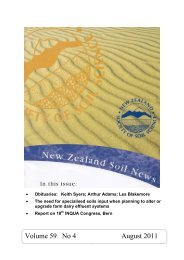Download - New Zealand Society of Soil Science
Download - New Zealand Society of Soil Science
Download - New Zealand Society of Soil Science
You also want an ePaper? Increase the reach of your titles
YUMPU automatically turns print PDFs into web optimized ePapers that Google loves.
Kinetics <strong>of</strong> molybdate and phosphate sorption by some Chilean Andisols<br />
Erika Marina Vistoso G. 1 , Nanthi S. Bolan 2 , Benny K.G. Theng 3 , Maria de la Luz Mora 4<br />
1 National Institute for Agricultural Research (INIA), Remehue Research Centre, Osorno, Chile<br />
2 Centre for Environmental Risk Assessment, University <strong>of</strong> South Australia, SA 5095, Australia<br />
3 Landcare Research, Private Bag 11052, Palmerston North 4442, <strong>New</strong> <strong>Zealand</strong><br />
4 Departamento de Ciencias Quimicas, Universidad de la Frontera, Temuco, Chile<br />
The kinetics for the sorption <strong>of</strong> molybdate and phosphate by four Chilean Andisols have been<br />
determined. About 55% <strong>of</strong> the molybdate and 61% <strong>of</strong> the phosphate was sorbed in the first 0.5 h, after<br />
which sorption slowly increased, reaching 90% for molybdate and 97% for phosphate after 72 h. At<br />
the same time, OH – ions were released into the external solution, raising its pH by 0.85 units for<br />
molybdate and by 0.65 units in the case <strong>of</strong> phosphate. These observations indicated that both anions<br />
were sorpbed by a ligand exchange mechanims. Among the five kinetic models examined (Table, 2),<br />
the Elovich equation gave the best fit <strong>of</strong> the experimental data (R 2 = 0.93 to 0.97, standard error = 0.35<br />
to 0.94). The sorption rate constant (α) for both anions was related to the organic matter (OM) content<br />
<strong>of</strong> the soils, especially the content <strong>of</strong> Al- and Fe-humus complexes. The values for molybdate were<br />
2.24x10 15 mmol kg –1 h –1 for the Vilcún soil (15% OM), 2.49 x10 12 mmol kg –1 h –1 for the Pemehue soil<br />
(16% OM), 8.76x10 10 mmol kg –1 h –1 for the Osorno soil (20% OM), and 3.11x10 7 mmol kg –1 h –1 for<br />
the Piedras Negras soil (24% OM). The corresponding values for phosphate were 3.89x10 7 , 5.21x10 10 ,<br />
3.11x10 12 and 1.08x10 16 mmol kg –1 h –1 . The desorption rate constant (β) for the four soils (in the above<br />
order) ranged from 0.47 to 0.28 for molybdate, and 0.22 to 0.39 mmol kg –1 h –1 for phosphate. The<br />
results suggest that the mineralogical composition and organic matter content <strong>of</strong> the Andisols control<br />
the kinetics for the sorption <strong>of</strong> both molybdate and phosphate. Molybdate appeared to have a high<br />
affinity for Fe- and Al-oxides, while phosphate was largely sorbed to Fe-and Al-humus complexes.<br />
Journal <strong>of</strong> <strong>Soil</strong> <strong>Science</strong> and Plant Nutrition 9: 55–68, 2009<br />
__________________<br />
Effect <strong>of</strong> elevated CO2 on soil N dynamics in a temperate grassland soil<br />
Christoph Müller a,b , Tobias Rütting c , M. Kaleem Abbasi b,d , Ronald J. Laughlin e ,<br />
Claudia Kammann a,b , Tim J. Clough f , Robert R. Sherlock f , Jens Kattge g , Hans-Jürgen Jäger b ,<br />
Catherine J. Watson e , R. James Stevens e<br />
a School <strong>of</strong> Biology and Environmental <strong>Science</strong>, University College Dublin, Belfield, Dublin 4, Ireland<br />
b Department <strong>of</strong> Plant Ecology, Justus-Liebig University Giessen, Heinrich-Buff-Ring 26, 35392 Giessen, Germany<br />
c Department <strong>of</strong> Plant and Environmental <strong>Science</strong>s, University <strong>of</strong> Gothenburg, Box 461, 405 30 Gothenburg, Sweden<br />
d<br />
Faculty <strong>of</strong> Agriculture, University <strong>of</strong> Azad Jammu & Kashmir, Rawalakot, Azad Jammu & Kashmir, Pakistan<br />
e<br />
Agriculture, Food and Environmental <strong>Science</strong> Division, Agri-Food and Biosciences Institute, <strong>New</strong>forge Lane, Belfast BT9<br />
5PX, Northern Ireland<br />
f<br />
Agriculture & Life <strong>Science</strong>s Division, Lincoln University, PO Box 84, Canterbury, <strong>New</strong> <strong>Zealand</strong><br />
The response <strong>of</strong> terrestrial ecosystems to elevated atmospheric CO 2 is related to the availability <strong>of</strong><br />
other nutrients and in particular to nitrogen (N). Here we present results on soil N transformation<br />
dynamics from a N-limited temperate grassland that had been under Free Air CO 2 Enrichment (FACE)<br />
for six years. A 15 N labelling laboratory study (i.e. in absence <strong>of</strong> plant N uptake) was carried out to<br />
identify the effect <strong>of</strong> elevated CO 2 on gross soil N transformations. The simultaneous gross N<br />
transformation rates in the soil were analyzed with a 15 N tracing model which considered<br />
mineralization <strong>of</strong> two soil organic matter (SOM) pools, included nitrification from NH 4 + and from<br />
organic-N to NO 3 - and analysed the rate <strong>of</strong> dissimilatory NO 3 - reduction to NH 4 + (DNRA). Results<br />
indicate that the mineralization <strong>of</strong> labile organic-N became more important under elevated CO 2 . At the<br />
same time the gross rate <strong>of</strong> NH 4 + immobilization increased by 20%, while NH 4 + oxidation to NO 3 - was<br />
reduced by 25% under elevated CO 2 . The NO 3 - dynamics under elevated CO 2 were characterized by a<br />
52% increase in NO 3 - immobilization and a 141% increase in the DNRA rate, while NO 3 - production<br />
via heterotrophic nitrification was reduced to almost zero. The increased turnover <strong>of</strong> the NH 4 + pool,<br />
combined with the increased DNRA rate provided an indication that the available N in the grassland<br />
soil may gradually shift towards NH 4 + under elevated CO 2 . The advantage <strong>of</strong> such a shift is that NH 4<br />
+<br />
is less prone to N losses, which may increase the N retention and N use efficiency in the grassland<br />
ecosystem under elevated CO 2 .<br />
<strong>Soil</strong> Biology & Biochemistry 41 (2009) 1996–2001<br />
182










